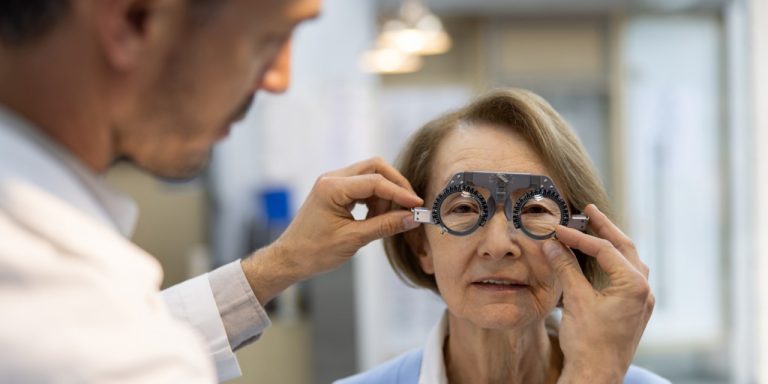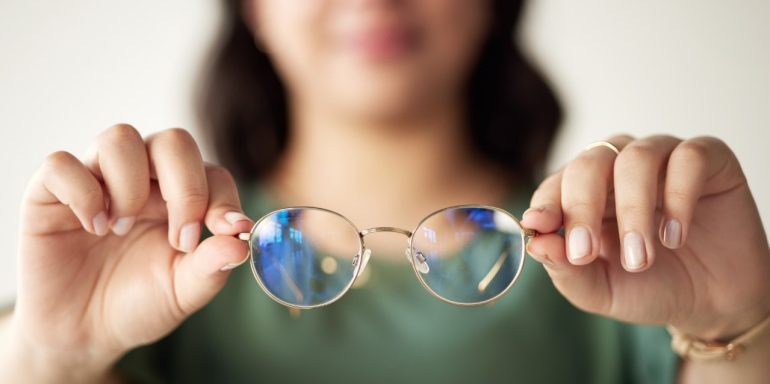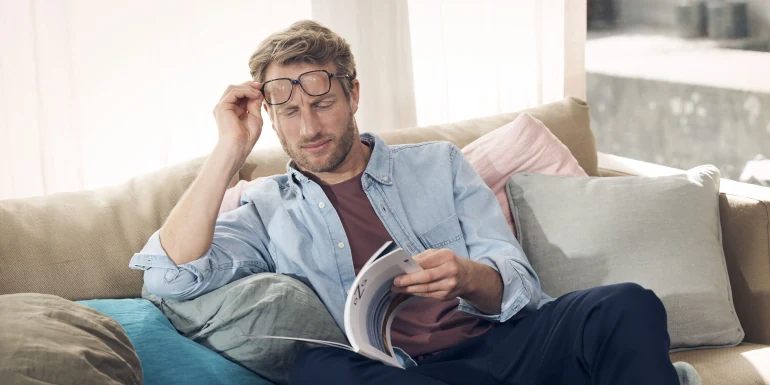Presbyopia: causes, symptoms and treatment
As we get older, we start to notice the onset of age-related long-sightedness (presbyopia). But what exactly is it? Can you use laser treatment for presbyopia? Is there any way to prevent it? Find out about presbyopia and the treatment options.

What is age-related long-sightedness?
Age-related long-sightedness, or presbyopia, is a natural change in the way our eyes work. Presbyopia by definition is not an illness; it’s just part of the ageing process. But when does it set in? People tend to notice the first signs of age-related long-sightedness in their early forties (depending on existing eyesight issues). Around this age, it can be increasingly difficult to see close-up objects clearly.
Note: Some people also talk about “age-related short-sightedness”. However, this is misleading and technically incorrect. There is no such thing as age-related short-sightedness.
Presbyopia: what causes it?
Age-related long-sightedness is caused by a change to the lens in the eye. Normally, the lens adapts to different distances (accommodation). This allows us to see things clearly whether they are close up or far away. But as we get older, the lens loses its elasticity, becoming more rigid and less adaptable. This shifts the point at which we can still see things clearly; close-up objects will start to seem blurry, while distant objects will usually remain clear. The range in which we can see things clearly, known as the range of accommodation, also decreases.
Experts measure the range of accommodation in dioptres. The onset of age-related long-sightedness causes our dioptre value to fall. The dioptre table below shows how this value changes once presbyopia sets in:
|
|
|
|---|---|
|
|
|
|
|
|
|
|
|
|
|
|
|
|
|
|
|
|
|
|
|
|
|
|
|
|
|
|
|
|
|
|
|
|
|
|
|
|
|
Age
Average range of accommodation in dioptres
10 years
14.0 to 13.0 dioptres
15 years
12 dioptries
20 years
10 dioptries
25 years
8 dioptries
30 years
7 dioptries
35 years
5.5 dioptres
40 years
4.5 dioptries
45 years
3.5 dioptries
50 years
2.5 dioptries
55 years
1.5 dioptries
60 years
1.0 dioptries
65 years
0.5 dioptries
70 years
0 dioptries
Age-related long-sightedness: symptoms
Presbyopia has various symptoms. Visual perception gets worse in weak light. People with presbyopia find it difficult to read when the lights are dimmed. Many will instinctively hold the book or magazine they are reading further away from them. Other symptoms include tiredness and burning eyes that struggle to focus. Age-related long-sightedness can also cause headaches if left untreated. The symptoms of presbyopia change over time.
Note: Have you noticed a rapid deterioration in your vision due to age-related long-sightedness? Then speak to your ophthalmologist. Presbyopia usually develops gradually. A sudden deterioration in your vision may indicate a disorder such as inflammation of the optic nerve or high blood pressure.
Short-sightedness, long-sightedness, age-related long-sightedness
Practically everyone will experience changes in their vision as they get older. Age-related long-sightedness often develops in addition to existing short-sightedness (myopia) or long-sightedness (hyperopia).
Age-related long-sightedness and short-sightedness
Presbyopia and myopia (short-sightedness) have various causes and affect our vision in different ways. For anyone who is already short-sighted, age-related long-sightedness can be an advantage. In some cases, the two will effectively cancel each other out, with the age-related long-sightedness only becoming apparent later.
Long-sightedness and age-related long-sightedness
Hyperopia (long-sightedness) and presbyopia both affect our ability to see things up close. Long-sighted people find it difficult to see objects clearly from close range, from the moment they are born. This is often caused by a shortened eyeball. Age-related long-sightedness, on the other hand, only sets in later in life, and it also affects people who have never had difficulty seeing objects up close. Long-sighted people tend to notice age-related long-sightedness earlier on and require visual aids sooner. Cases where long-sightedness and age-related long-sightedness occur simultaneously require a stronger correction.
Presbyopia and astigmatism
Astigmatism (or corneal irregularity) is caused by an unusual curvature of the cornea. It can result in blurred or distorted vision both close up and at distance. Astigmatism is usually congenital. Those who suffer from the condition have significantly reduced vision, often starting in childhood. Although astigmatism can occur on its own, it may also be accompanied by other vision problems, including age-related long-sightedness.
Presbyopia: testing your vision
Do you think you might be affected by age-related long-sightedness? Consult your ophthalmologist. They will ask you some questions about your symptoms and test your vision by asking you to read from a letter chart. This will usually be followed by further examinations using an autorefractor or a phoropter, for example. These devices enable the ophthalmologist to determine the exact degree to which your vision is affected by age-related long-sightedness.
Treating age-related long-sightedness
There are various ways of treating presbyopia. Below we take a look at the different options.
Laser treatment for presbyopia
Some people decide to have laser eye surgery for their age-related long-sightedness. Laser treatment has proved effective for eye diseases such as glaucoma. However, it is only recommended for age-related long-sightedness in certain cases. Whether it’s an option for you will depend on your circumstances and the degree of your visual impairment. Your ophthalmologist will be able to tell you whether this particular form of presbyopia treatment is right for you.
Laser treatment for presbyopia: costs
If you do decide to have laser treatment for your age-related long-sightedness, you will most likely have to pay for it yourself. As a rule, health insurance companies do not cover the costs of laser eye surgery for age-related long-sightedness. The costs of the procedure vary depending on the method used.
Surgery for presbyopia
There are also surgical options when it comes to treating age-related long-sightedness. These include an artificial replacement for the lens in the eye. This procedure is particularly suited to cases where there is evidence of cataracts, short- or long-sightedness or astigmatism along with the presbyopia. However, the operation does come with potential disadvantages. The patient may find their vision deteriorating at dawn and dusk and during the night. The glare from certain light sources may be particularly blinding following the procedure. Ask your ophthalmologist if surgery is a viable option for treating your presbyopia.
It’s worth noting that corneal implants have not been widely adopted as a method for correcting age-related long-sightedness.
Correcting presbyopia with visual aids
Visual aids are the traditional way of treating age-related long-sightedness. Glasses are an obvious choice, and there are various options available:
- Bifocals: these are glasses in which the lens is divided into separate areas, one for long distance and one for short distance. There is a visible line between the two areas of the lens, and some people find this annoying.
- Trifocals: aside from short and long distance, these glasses also cover a medium range of vision. However, the change from one area of the lens to another is quite abrupt and, as with bifocals, each area is separated by a visible line.
- Varifocals: these glasses allow seamless transition between short, medium and long distance to counter the effects of presbyopia. There are no lines between the different areas of the lens, which makes them more comfortable to wear. However, it can take a while to get used to varifocals, and some people experience headaches and dizziness to begin with.
Contact lenses are another suitable visual aid for correcting age-related long-sightedness. There are bifocal and multi-focal options available, both of which work in a similar way to glasses. Your ophthalmologist can help you choose the right kind of contact lenses.
Presbyopia: costs for visual aids
Our COMPLETA supplementary insurance covers 90% of the costs of spectacle lenses and contact lenses up to CHF 300 per calendar year. With COMPLETA PLUS, you also receive 90% of the costs, up to a maximum of CHF 200 per calendar year, that exceed the COMPLETA benefits.
Preventing presbyopia
There’s no way to prevent presbyopia – it’s part of the body’s natural ageing process. You can find exercises for age-related long-sightedness online. However, they won’t do much to prevent the onset of presbyopia. The same goes for taking vitamins to ward off age-related long-sightedness. In principle, a balanced diet will have a positive effect on overall eye health. However, it won’t help you avoid presbyopia.
You can’t train your way out of age-related long-sightedness, but there are a number of effective treatments available. Visual aids such as glasses or contact lenses are both excellent ways to compensate for any loss of vision. Contact your ophthalmologist for advice.
Articles about this topic
Do you have questions?
We're here to help.


